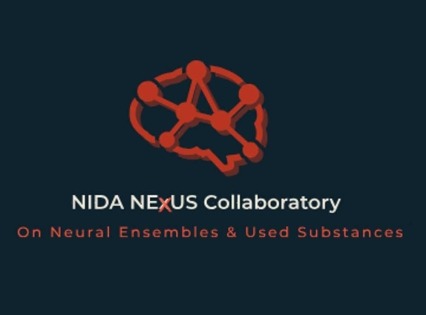
The aspirational goal of NIDA NExUS is to enable a better understanding of neural coding in Substance Use Disorders (SUDs), by delivering consensus molecularly annotated maps of cell ensembles engaged by used substances.
Ensembles are collections of one or more neurons whose firing activity co-varies or explains variance in a decoded variable (such as a location in an environment, plasma drug level or action in an operant self-administration task).
NExUS aims to understand how cellular composition/molecular typing, connectomic architecture, morphoelectric properties and activity dynamics of cells in functional neural ensembles contribute to the coding of drug-associated experiences.
- Short term deliverable: Share and harmonize multimodal data generated across multiple relevant NIDA-funded projects (including with public resources such as BICAN and SCORCH) to establish a molecular repository and spatial map/atlas of cell ensembles engaged by a range of substance use experiences.
- Longer term deliverable: Develop new testable theoretical and computational models of how substance use experiences are represented by ensembles of neural cells, and enable tests of their behavioral relevance.
Core questions
- What is the composition and architecture of functional cell ensembles engaged by drug experiences (cell identities & locations & connections)?
- Can a common coordinate/anatomical framework be adopted across projects to define distributed ensembles engaged by drug experiences?
- How do drug-associated cell ensembles relate to pharmacological target distribution/ engagement (receptor/messenger) across circuits?
- How do drug-associated cell ensembles differ within and across drug classes, route, and regimens (opioids, stimulants, cannabinoids, etc.)?
- How do drug-associated cell ensemble organization and dynamics evolve with use repetition, learning, and expectation (acute vs chronic, contexts vs cues, control, abstinence, etc.)?
Researchers
Investigators from 11 projects on opioids funded through NOFOs PAR-20-241 (2020), PAR-20-182 (2021), RFA-DA-22-011 (2021), and RFA-DA-23-035 (2022). RFA-DA-25-023 (all addictive substances) is currently active. The related RFA-DA-23-036 solicited proposals with a developmental focus with one project funded in 2023. These projects complement those in the SCORCH Program (Single Cell Opioid Responses in the Context of HIV).
Funded NIDA NEXUS Collaboratory Projects
- Transcriptional, functional, and circuit profiling at single cell resolution of neuronal ensembles engaged by heroin relapse (R01DA054317), University of Washington (Garret D. Stuber, Susan Marie Ferguson)
- Mapping opioid-dependence state transitions across structural, functional, and transcriptomic topologies (R01DA054374), University of Pennsylvania (Julie A. Blendy, Gregory Corder)
- A comprehensive dissection of cell types, circuits and molecular adaptations during opioid use (R01DA054583), University of North Carolina Chapel Hill (Gregory Scherrer, Mark J. Schnitzer, Hongkui Zeng)
- Single-Cell Dissection of Ensembles and Cell Types Mediating Opioid Action in the Rodent Brain (R01DA054584), Massachusetts Institute of Technology (Myriam Heiman, Veronica Alvarez, Manolis A. Kellis)
- Genomic profiling mediating the protective effect of social reward on opioid craving (R01DA056440), University of Maryland Baltimore (Marco Venniro, Seth Ament, Mary K. Lobo)
- Circuitry dynamics underlying opioid-dependence: Integrating structural, functional, and transcriptomic mechanisms (R01DA056599), University of Pennsylvania (Gregory Corder, Kevin T, Beier, Danielle Smith Bassett, Julie A. Blendy)
- Multiomic profiling of cell types mediating opioid use disorder in rats (R01DA056602), University of California, San Diego (Francesca Telese)
- Ventral pallidal transcriptional adaptations underlying punishment-resistant opioid intake (R01DA056829), Washington University (Meaghan C. Creed, Vijay K. Samineni)
- Integrative single-cell spatial transcriptomic, anatomical, and functional profiling of brain-wide ensembles engaged by opioid relapse (R01DA059374), University of Washington (Sam Golden, Liancai Gu, John F. Neumaier, Nicholas Steinmetz)
- Mapping brain-wide opioid actions by profiling neuronal activities and in vivo cellular target engagement (R01DA059393), The Scripps Research Institute (Li Ye, Laura M. Bohn, Ryan Ashok Shenvi)
- Multi-modal profiling of spatially resolved cell types mediating opioid withdrawal (R01DA059602), Stanford University (Xiaoke Chen, Bogdan Bintu, Quan Zhu)
- The impact of early life opioid exposure on the molecular and functional trajectories of septal cell types (R01DA059388), University of California, San Francisco (Corey C. Harwell, Garret D. Stuber)
Questions
If you have questions about these projects and funding announcements, please contact program officers Olivier Berton (olivier.berton@nih.gov) or John Satterlee (satterleej@nida.nih.gov)
